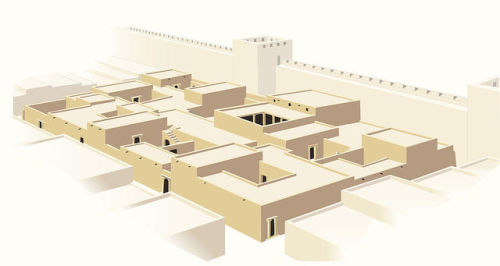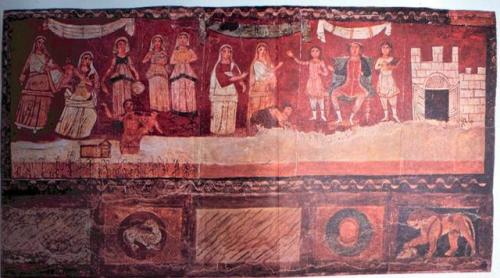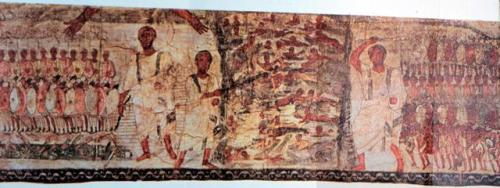#asianhistory
Compiled by Asians4BlackLives primarily based on research by AATimeline,VietUnityandSEARAC
From January 19-25, 2019, impacted communities, social justice and advocacy organizations, and other allies across the country will launch a national week of action to stand with Southeast Asian American communities as they continue to be terrorized by policies of mass incarceration and deportation. This week of action, which spans 15 cities across the country, is on the heels of one of the largest Southeast Asian deportation flights in United States history and coincides with Martin Luther King Jr. Day. In honor of Dr. King’s memory, we call on our country to remember the three evils—racism, militarism and poverty—that continue to devastate and divide Southeast Asian, Black and Brown communities: bit.ly/SEAAWeekofAction
The timeline below was developed to help the public learn about the connection between US imperialism and war in Southeast Asian and the current struggle of Southeast Asian immigrant and refugee communities against deportations. A downloadable PDF version is available which can be folded into a mini-zine.
1953
The U.S. provides military aid to France to suppress Vietnam freedom fighters, helping France maintain Vietnam as its colony.
1961
U.S. involvement in the “Secret War” in Laos deepens. U.S. presence in Laos aids its military presence in Vietnam. The CIA recruits Hmong and other ethnic minority groups living in Laos to guerilla units fighting for the Royal Lao Government. Details of this war were not disclosed to the public, and were often completely denied.
1963
A U.S.-approved military coup overthrows President Ngô Đình Diệmin of Vietnam.
1965
President Lyndon B. Johnson deploys American combat troops to Vietnam. Domestic demonstrations against the U.S. war in Vietnam begin.
1964-73
The U.S. drops more than 2.5 million tons of ordnance on Laos over the course of 580,000 bombing missions. This is equal to a planeload of bombs every 8 minutes, 24-hours a day, for 9 years.
1965-1973
The U.S. drops 2,756,941 tons of ordnance on Cambodia. This is more than the Allies dropped in the entirety of World War II. Information about the first four years of bombing was not made public until 2000.
1968
My Lai Massacre – US soldiers kill as many as 504 Vietnamese civilians including 119 children & 27 elderly.
1973
The U.S. & North Vietnam sign a ceasefire agreement.
The U.S. withdraws troops from Laos.
1975
The U.S. War in Vietnam comes to an end.
U.S. war and military presence in Southeast Asia leads to the rise of oppressive governments in both Cambodia & Laos. After a 5-year civil war in Cambodia, the Khmer Rouge captures the capital city of Phnom Penh and a genocide of 1-3 million people begins in Cambodia.
The U.S. authorizes the entry of 130,000 evacuees from Vietnam, Cambodia, & Laos.
1978
A second wave of refugees begin to leave Vietnam, many by sea. Journeys by boat are dangerous and many refugees don’t survive the trip. Many countries become unwilling to accept refugees.
1979
The UN establishes the Orderly Departure Program to deal with various waves of refugees leaving Southeast Asia. The U.S. becomes the largest country of second asylum. People continued to leave their homelands as a result of the U.S. War in Vietnam through the early 1990s.
1980
U.S. Congress passes the Refugee Act.
1987
In California the Creation of the Gang Reporting Evaluation & Tracking database heightens the profiling and flagging youth of color as gang members.
1980s-1990s
Many Southeast Asian refugees resettle in already underserved neighborhoods and must compete for low-wage jobs or face unemployment. Many lack access to health care, mental health services, and support for Post-Traumatic Stress Disorder.
The rise of the school to prison pipeline: over-stretched public schools with inadequate resources lead to disengagement and dropouts with youth then being pushed into violence and juvenile detention facilities with few pathways to return to school.
1994
A national report finds that more than 30 percent of all Southeast Asian households in the US depend on welfare for survival. Among Cambodian and Laotian communities in California, the percentage of those on welfare reaches 77 percent.
The state of California passes Proposition 187, denying undocumented immigrants public services like education & healthcare.
The state of California passes Proposition 184, Three Strikes Sentencing Initiative, the nation’s toughest mandatory sentencing law.
U.S. Congress passes the Violent Crime Control and Law Enforcement Act, the largest crime bill in the history of the U.S. It provided for 100,000 new police officers, $9.7 billion in funding for prisons, $1.2 billion for border control, deportations, asylum reform and a tracking center for immigrants with convictions., $1.8 billion to reimburse states for incarceration of immigrants who also had convictions. . It also expedited deportation for immigrants who are not lawful permanent residents and who are convicted of aggravated felonies.
1996
U.S. Congress passes the Personal Responsibility and Work Opportunity Reconciliation Act, a welfare reform bill. Immigrants who were on welfare were immediately removed if they were in the US for less than 5 years. Only immigrants who have been in the US for over 5 years can receive welfare.
U.S. Congress passes the Illegal Immigration Reform & Immigrant Responsibility Act, setting mandatory detention and deportation laws that apply retroactively, making refugees and lawful permanent residents vulnerable to deportation. Forms of immigration relief previously available to people with convictions are eliminated. It also eliminates judicial review for cases.
2001
U.S. Congress passes the USA Patriot Act after September 11th, ushering in a new era of racial profiling, immigrant detentions, and deportations.
2002
First repatriation agreement between U.S. and Cambodia for Cambodia to accept deportees.
2008
The U.S. signs an agreement with Vietnam not to deport Vietnamese immigrants who entered the U.S. before July 12, 1995.
2017
The U.S. sanctions visas for Cambodia, Laos, and Myanmar to pressure them to accept deportees.
2018
The U.S. goes back on its 2008 agreement with Vietnam in an attempt to deport more Vietnamese people.
More than 110 Cambodian people are deported in the calendar year, the highest number in U.S. history. 750+ Cambodian, 200+ Laotian, and 550+Vietnamese community members have been deported since 2002.
Additional sources: Legacies of War. “Secret War in Laos.” Legacies of War, legaciesofwar.org/about-laos/secret-war-laos/; Taylor Owen. “Bombs Over Cambodia.” The Walrus, thewalrus.ca/2006-10-history/; Ashley Dunn. “Southeast Asians Highly Dependent on Welfare in U.S.” The New York Times archive, https://www.nytimes.com/1994/05/19/us/southeast-asians-highly-dependent-on-welfare-in-us.html.
The Dura Europos Synagogue, Dura Europos, Syria. Images of the Excavation and Frescoes via the Yale University Art GalleryandYale Divinity School Eikon Database.
Initially, I had preplanned this post in light of the upcoming Jewish holiday of Pesach (in English, Passover), which begins at sundown on April 10th, 2017. In the 1920′s and 1930′s, Yale University and the French Academy of Inscriptions and Letters began excavation work of the Roman city of Dura Europos, located in modern day Syria.

As an archaeological site, Dura Europos provided a early archaeologists with an amazing view into the expanses of the Roman Empire, and the great diversity which existed within this city. The city has provided endless fascinating discoveries: it gives us our earliest found example of Chemical Warfare between the Sassanids and the Romans in 265 CE, as well as the earliest found example of a Christian Church, and the earliest found example of a Jewish Synagogue at the site, where inscriptions inform us that in 244 CE, a Jewish leader of the local community enlarged and refurbished the synagogue.
The frescoes beautifully illustrate a variety of scenes from the Jewish Tanakh (Hebrew Bible), including scenes following Moses’ life in the Book of Exodus. Above are two fresco scenes: the first depicts the infancy of Moses, and his rescue from the Nile, before the wife of the Pharaoh hands her adopted son to Moses’ real mother, who then serves as his Hebrew nursemaid. The second is a later scene which moves from left to right.
The scene begins with Moses leading the Israelites out of Egypt, then transitions, showing Moses raising his staff as the parted seas crash down upon Egyptian armies, before the scene ends with Moses and the Israelites standing together under the outstretched hands of God, having successfully survived their flight from Egypt.
And this is where this planned post took another course – I could not write about the history of Dura Europos without discussing the present of Dura Europos, and the state of Syria. Due to ISIL/Daesh activity, Dura Europos has been one of many archaeological or historical sites attacked. As a historian who works with artistic and archaeological material, I understand that the destruction of our past is a dangerous thing, and that destroying heritage and culture (especially of minority religions) is a part of terrorism.
However, I also understand that it is our human duty to be concerned for humanity first, and objects second.
The story of Exodus is a story of refugees, and it therefore feels imperative to talk about the refugees of today. In this case, the story is about Syrian refugees, but in 2015, the UNCHR estimated that about 60 million people in the world are refugees, internally displaced, or seeking asylum. Syrians accounted for roughly 11 million of those people. The Syrian Jewish community has dwindled over several decades: in the 1970′s, the population of Syrian Jews was roughly 4,600 people. Over the course of about thirty years, Canadian music teacher Judy Feld Carr helped smuggle some 3,228 Syrian Jews out of Syria. By 2014, the total Jewish population of Syria was thought to be under twenty remaining people, and after a 2015 rescue operation for the Halabi family organized by Israeli Authorities and assisted by Muslim rebels in Aleppo, it is suspected the remaining number of Jews in Syria is zero, or close to it.
The refugee and humanitarian crisis of Syria is not over, however. And while no one person can fix it, each person willing to put forth the effort to help can improve the world. Or, in other words –
You are not obligated to complete the work,
but neither are you free to abandon itלֹא עָלֶיךָ הַמְּלָאכָה לִגְמוֹר, וְלֹא אַתָּה בֶן חוֹרִין לִבָּטֵל מִמֶּנָּה
Pirke Avot,2:20
I know watching a humanitarian crisis anywhere in the world unfold can be overwhelming - and that we often feel like what we do doesn’t matter, or that there is no hope, or that we can’t singlehandedly fix the problems ourselves. Politics can overwhelm many people, threats of war can frighten us into complacency, and that sometimes terrifying times feel incomprehensible, even if we are the ones being affected by them. But I also know that each step gets us a little further to completing the work of making the world a better place.
Here is a listing of Charity Navigator’s highly rated charities working on the Syrian Crisis.
- Asianhistory Mod (Chag pesach sameach, Jewish followers)
Post link
清中期 玉壽星|God of longevityviaAsian Art
Medium: Jade (nephrite)Gift of Heber R. Bishop, 1902 Metropolitan Museum of Art, New York, NY
The above is a carving of the Chinese God of Longevity, Shou xing - one of the Sanxing, or Three Star gods. Shou Xing represents the star of the South Pole (Canopus) within Chinese astrology. The other two gods are Fu xing (Prosperity; the planet Jupiter), and Lu Xing (Status; the Zeta Ursa Majoris).
Shou is typically identifiable by his prominent and long forehead, obvious old age, and a peach in hand, symbolizing immortality. Sometimes additional imagery includes a crane or turtle, again emphasizing his symbolic longevity.
Oftentimes he is conflated with the Daoist deity “The Old Man of the South Pole,” or 南极老人. The Canopus star is also known in Korea, Vietnam, and Japan as the Star of Old Age. In Japan, the Canopus star representation becomes a part of the Seven Gods of Fortune, known as Jurōjin or 寿老人.
Post link
#inktober 25 - been reading a lot about badass women from ancient Mongolia and China lately ⚔
.
.
.
.
#ink #armor #warrior #spear #asianhistory #badassoftheweek #willkillforbasicrights #warriorprincess #illustration #painting #medieval
Post link







